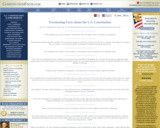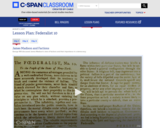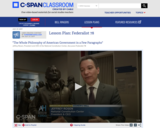
A list of fascinating facts about the United States Constitution
- Subject:
- History
- Social Science
- Social Studies
- Material Type:
- Reading
- Provider:
- ConstitutionFacts.com
- Date Added:
- 01/03/2023

A list of fascinating facts about the United States Constitution

The U.S. Constitution was written at the Philadelphia Convention, also known as the Constitutional Convention, and signed on September 17, 1787. It was ratified in 1789. The document established our nation's fundamental laws and government structures and ensured basic rights for American citizens.

This lesson addresses two essential questions: To what extent does the Bill of Rights provide a "blanket of protection" for American citizens? Why do many Americans believe that the Bill of Rights is especially relevant today?

A list of powers in the United States along with a graphic organizer to show whether these powers belong with the nation, state, or are shared. Easy reference for the student to use throughout the semester to identify who holds which powers. Can be used to assess understanding of power distribution also.

Explore the evolving division of duties and powers between the federal and state governments throughout the eras of federalism using an interactive timeline and associated resources.

As a part of the Federalist Papers, James Madison wrote Federalist No. 10 in 1787. In this essay, Madison defended the republican form of government created by the Constitution. He discussed the concepts of majority rule and minority rights and the factions in preventing tyranny. Clips from Journalist George Will and Senators James Lankford and Ted Cruz are included along with guiding questions about specific ideas found in Federalist 10.

This lesson explores the content, meaning, authorship, and application of Federalist 51. It contains various video clips and a graphic organizer to be used in analyzing Federalist 51.

As students read have them note the ways in which Hamilton says the judiciary's power will be limited.

In this lesson, students learn about the Bill of Rights and analyze primary sources from the Library of Congress to identify freedoms and rights. They will explore the questions: What are our rights? What freedoms are most important to you? Access to this resource requires a free educator login.

The first 10 amendments to the U.S. Constitution are known as the Bill of Rights. Those 10 amendments establish the most basic freedoms for Americans, including the rights to worship, speak, and peacefully assemble and protest their government how they want. The amendments have also been subject to much interpretation since their adoption, particularly the right to carry a gun under the Second Amendment.

This resource from the National Constitution Center includes an introduction, big questions, recorded class sessions, briefing documents, slide decks, and worksheets about the first amendment of the United States Constitutuion.

This resource from the National Constitution Center includes an introduction, big questions, recorded class sessions, briefing documents, slide decks, and worksheets about the first amendment of the United States Constitutuion.

In this lesson, students will gain an understanding of how the Supreme Court's interpretation of the First Amendment changed in light of the Fourteenth Amendment. They will also analyze Thomas Jefferson's Letter to the Danbury Baptist Association, evaluate the Supreme Court's application of Jefferson's metaphor about the wall of separation between church and state, and assess how much weight should be given to Jefferson's letter in determining the constitutionality of state action with respect to religion.

This resource from the National Constitution Center includes an introduction, big questions, recorded class sessions, briefing documents, slide decks, and worksheets about the first amendment of the United States Constitutuion.

This resource from the National Constitution Center includes an introduction, big questions, recorded class sessions, briefing documents, slide decks, and worksheets about the first amendment of the United States Constitutuion.

This resource from the National Constitution Center includes an introduction, big questions, recorded class sessions, briefing documents, slide decks, and worksheets about the first amendment of the United States Constitutuion.

This video covers the main parts of the first amendment in a fun way that is easy for kids to understand.

Florida v. Bostick (1991) asked the U.S. Supreme Court to determine whether consensual searches of passenger luggage aboard a bus violated the Fourth Amendment. The Court found that the location of the search was only one factor in a larger question of whether or not a person actually had the free will to decline the search.

Discover the work of Cornelia Adèle Fassett, one of the first female portrait artists of the 19th century to portray American presidents, politicians, and Supreme Court Justices.

Studio C (very funny sketch comedy channel hosted by BYU) skit on the founding fathers as a fraternity. Short funny video on the founding fathers. Can be used as an introductory activity.